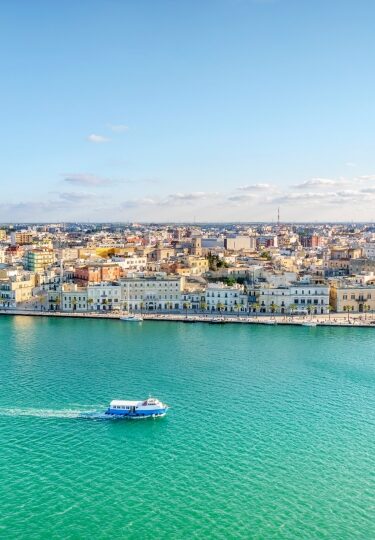Brindisi, Italy, is a handsome, lively port whose harbor walls are licked by the calm, aquamarine waters of the Adriatic. Located in the southerly region of Puglia, its streetside cafés and buzzy waterfront are warmed by some of the Italian peninsula’s sunniest weather.
The abundance of sunshine bakes the flagstones of its historic Piazza Duomo. These warm rays also contribute to the region’s famously flavorful produce that transforms even the most simple pasta dish on Brindisi’s restaurant menus into something special.
An under-the-radar gem, Brindisi offers a quintessentially Italian experience: delicious cuisine, vibrant culture, and mesmerizing history. So take time to explore this engaging southern port.
Why Visit Brindisi
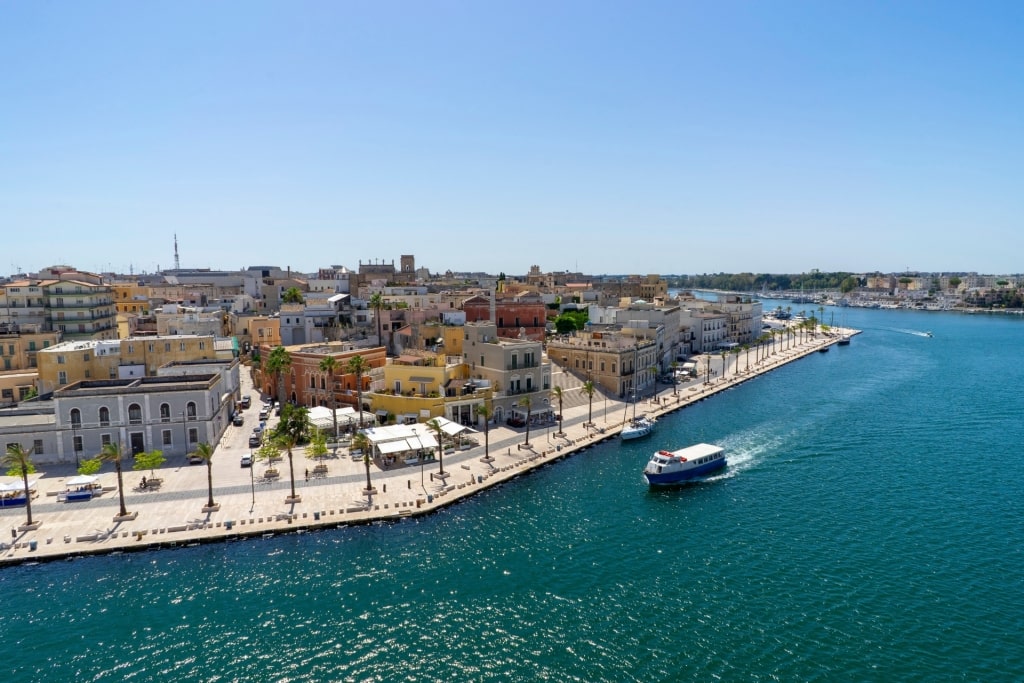
Brindisi
With sun, sea, and tarrali, the local crispy snack, Brindisi is a delightful small city to discover for an Italian coastal break. Primarily a port with major trade links to Greece, the Balkans, and the Middle East, Brindisi’s commercial importance stretches back to the Roman era.
From the city’s colorful Regina Margherita promenade, you’ll watch the boats navigating past the medieval Castello Alfonsino di Brindisi at the harbor entrance.
It is this easy mingling of the city’s ancient and modern faces that makes Brindisi such a joy to visit. The promenade fronts the compact Centro Storico, which can be crossed on foot in about 20 minutes.
A trip to Brindisi also places you at the heart of a day-trip-rich area of Southern Italy. Discover the trulli houses of Alberobello, the whitewashed lanes of Ostuni, or the baroque treasures of Lecce.
Compare the hue and translucence of the Adriatic shallows with those of the Ionian by traveling southeast to discover the beaches around the southern city of Taranto.
History & Culture
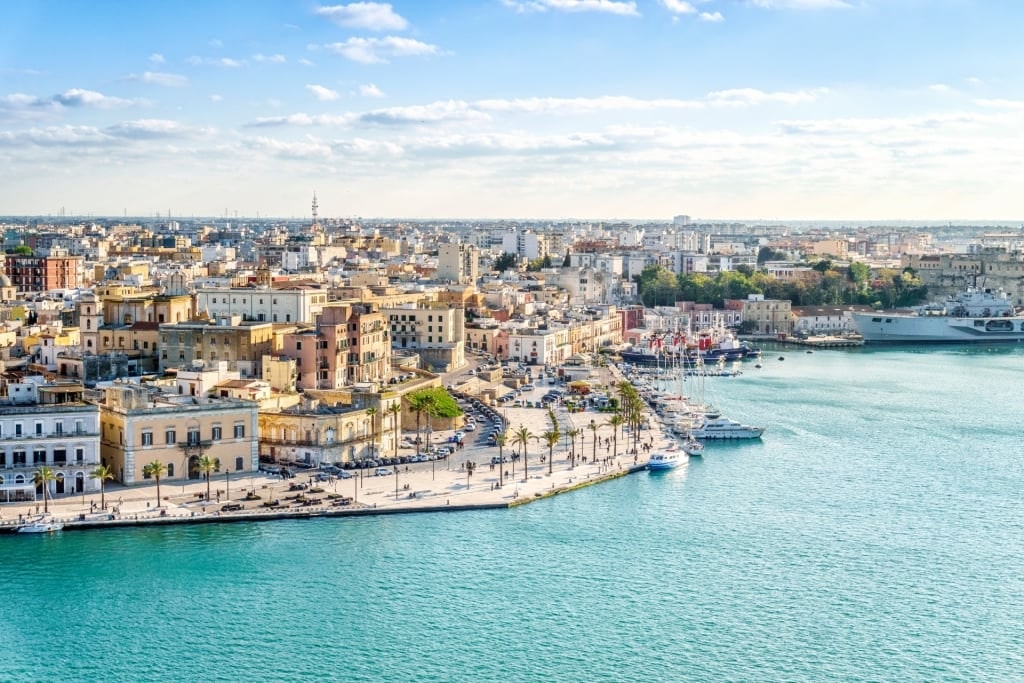
Brindisi
Brindisi has a long and complex history, with the city’s origins shrouded in myth. It’s generally accepted that the Cretans were likely the first to settle the fertile shores of this useful natural harbor. A more fanciful take has the Trojan War hero, Diomedes, as Brindisi’s founder.
Referred throughout its history as “The Gateway to the East”, Brindisi acted as an important center of Roman commerce and maritime power. You can witness the importance this city held for the Romans by visiting the lone Corinthian column that marks the end of the Via Appia, or Appian Way, the ancient road that connected the capital with Brindisi.
Another titbit of Brindisi’s Roman cultural history is that it was where the poet Virgil lived and eventually died in 19 BC. His ashes were taken to Naples, but the Virgil Staircase stands as a monument to his connection to the city.
In the centuries that followed the Roman era, this strategically important port passed between the Venetians, Spanish, Austrians, and Bourbons.
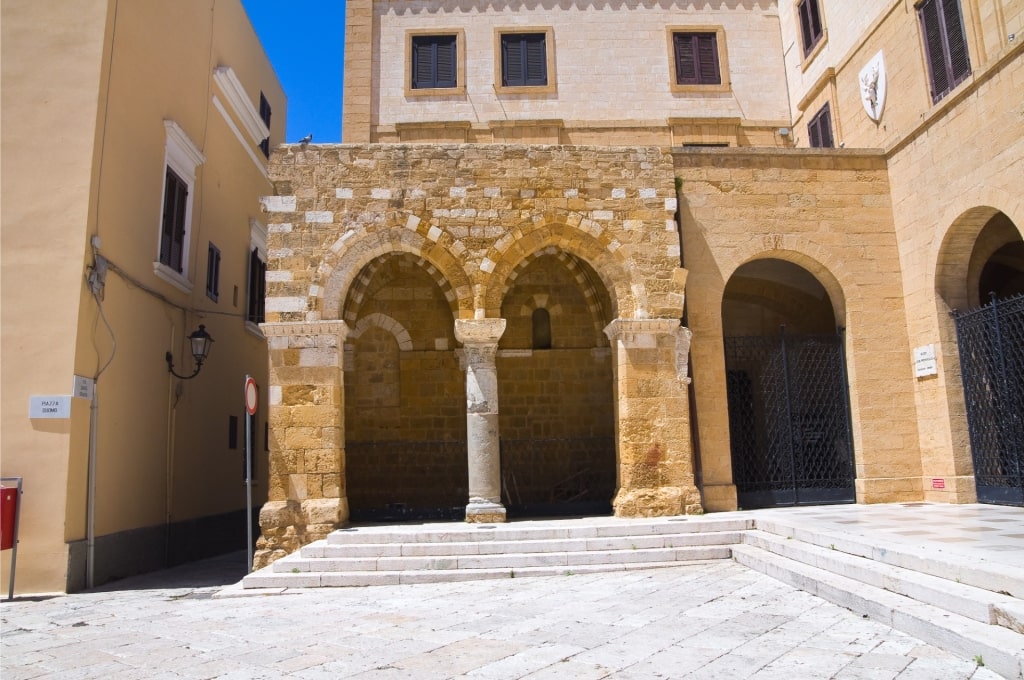
Portico dei Cavalieri Templari
While under Norman rule in the 12th century, it became a departure port for the Crusades. One school of thought has the Portico dei Cavalieri Templari, found close to the cathedral, as the final remaining piece of what was the Knights Templar’s main center of worship.
In the mid-20th century, Brindisi’s visibility rose once more into the national consciousness. Following the signing of the Armistice of Cassibile during WWII, Brindisi became the temporary home of the Italian government—as well as of its King—as its former allies, the Germans, swept through the rest of the country.
Tips for Visiting Brindisi, Italy
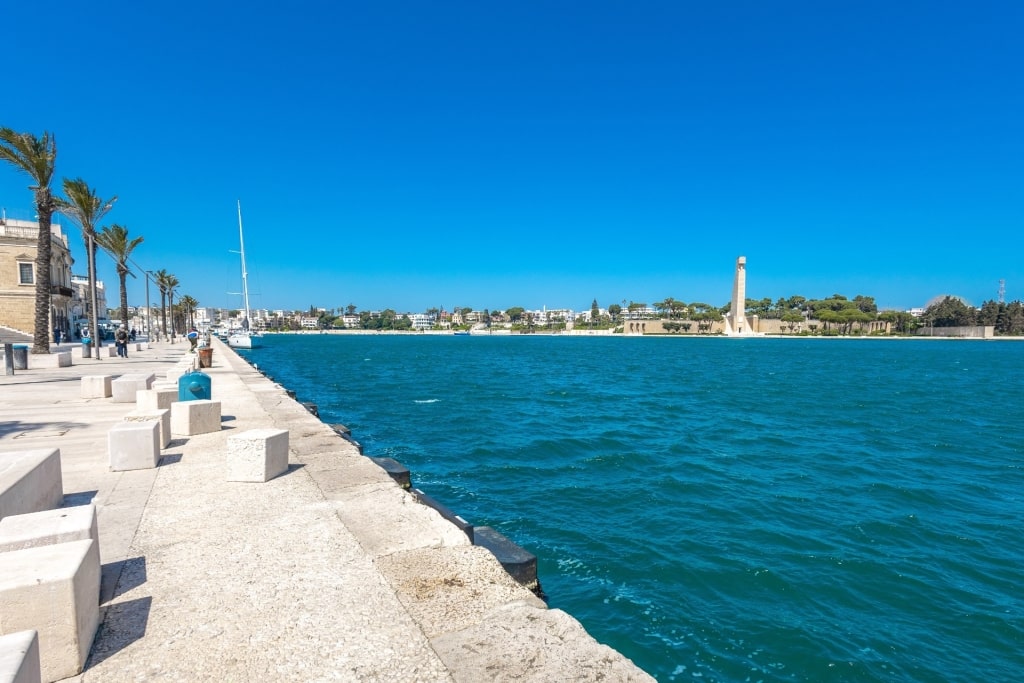
Brindisi Waterfront
Brindisi, Italy, is a thriving, modern Italian city. Most first-time visitors will pass through the vibrant outer neighborhoods to reach the waterfront Centro Storico, the location of its most attractive architecture and lively nightlife.
Its Piazza Duomo is found here, along with the majority of other significant buildings such as the Tempio di San Giovanni al Sepolcro and the Verdi Theater. The renovated, palm-lined lungomare, the seafront promenade, is a minimalist boardwalk that wraps around the baroque architecture of the historic center.
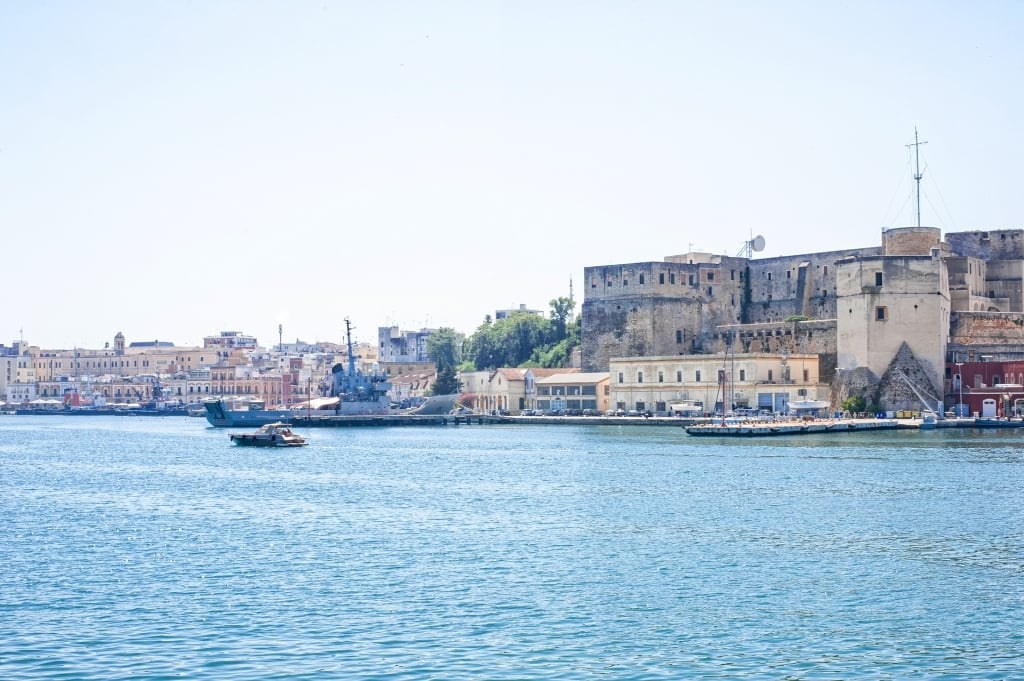
Castello Svevo
The promenade and the streets that lead off it are the center of life in Brindisi. As you walk beside the sailboat-filled harbor, you’ll pass modern art installations, market stalls, and the welcome sight of a pizzeria’s al-fresco seating on the white marble flagstones. You’ll also see Castello Svevo, a medieval fortress used by the Italian military.
Head inland into the palm-festooned heart of the Centro Storico for shopping and excellent cafes along Corso Umberto I or Corso Garibaldi.
A ten-minute water taxi will transport you from the Centro Storico to the northern side of the harbor. Here you’ll reach the Casale district, the location of a charming fisherman’s village that retains a distinct identity from the rest of Brindisi. Fishermen with quick smiles fix nets amid their blue-painted wooden boats.
Also on this side of the harbor is the rudder-shaped monument dedicated to Italian sailors—a modernist symbol of the city.
Things to Do & Attractions in Brindisi, Italy
See the End of the Via Appia Antica
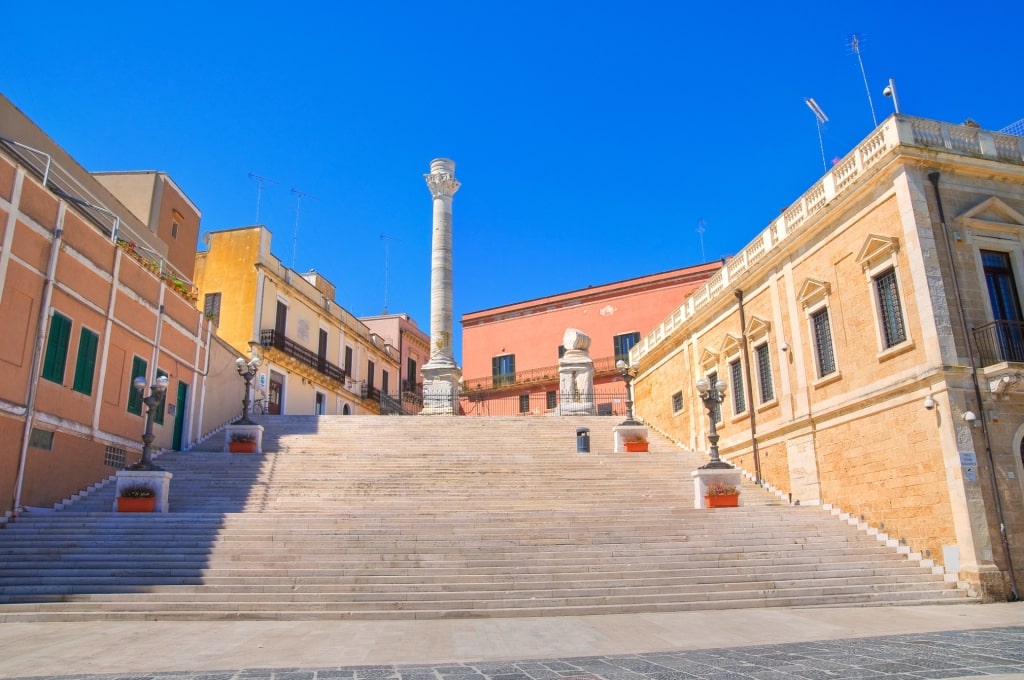
Via Appia Antica
The Appian Way or “Via Appia Antica” is a 342-mile road that connects Rome with Brindisi. Begun in 312 BC, its original purpose was to enable the conquest of southern Italy.
This “queen of the long-distance roads”, as the poet Horace described it, bore silent witness to many dramatic moments in history. One of the most gory was when Spartacus and his slave army were crucified by its side in 71 BC.
Near Rome, its pine-shaded verges are home to numerous archaeological sites. At its conclusion in Brindisi, Italy, an evocative Corinthian column stands atop the Virgil Staircase to mark the concluding point of this epic piece of Roman infrastructure. You’ll find it, and its crumbled twin, close to the promenade.
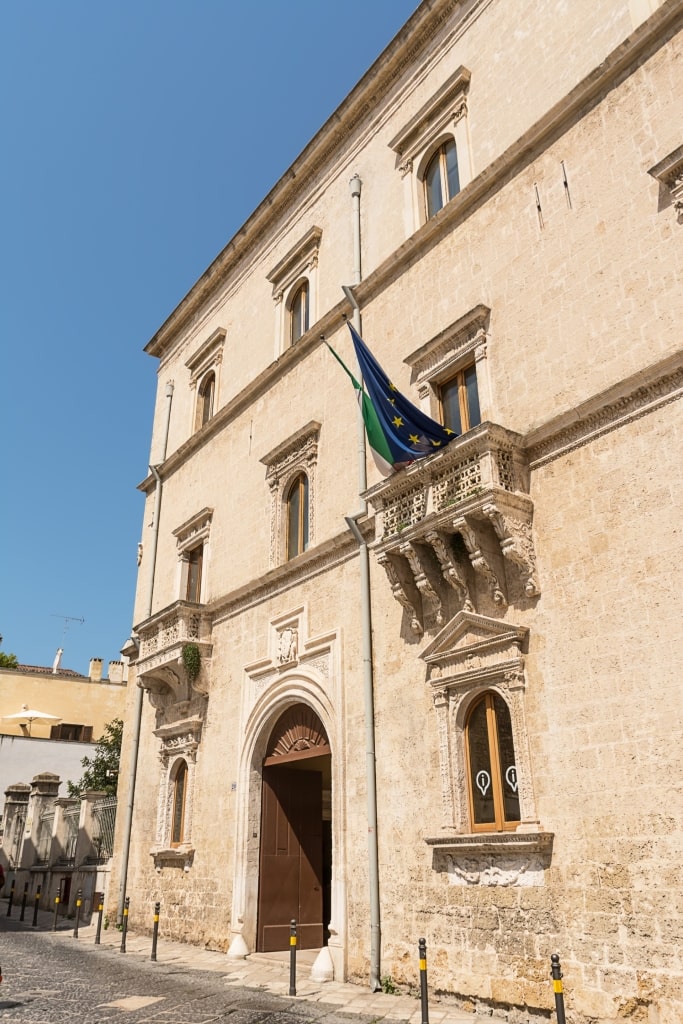
Palazzo Granafei-Nervegna
To get a closer look at the ornate capital of the column, head to the Palazzo Granafei-Nervegna where the twin’s capital is on display. This 16th-century palazzo-turned-cultural center also contains art exhibitions, the Brindisi tourist office, and the archeological remains of a Roman house.
Explore the Piazza Duomo
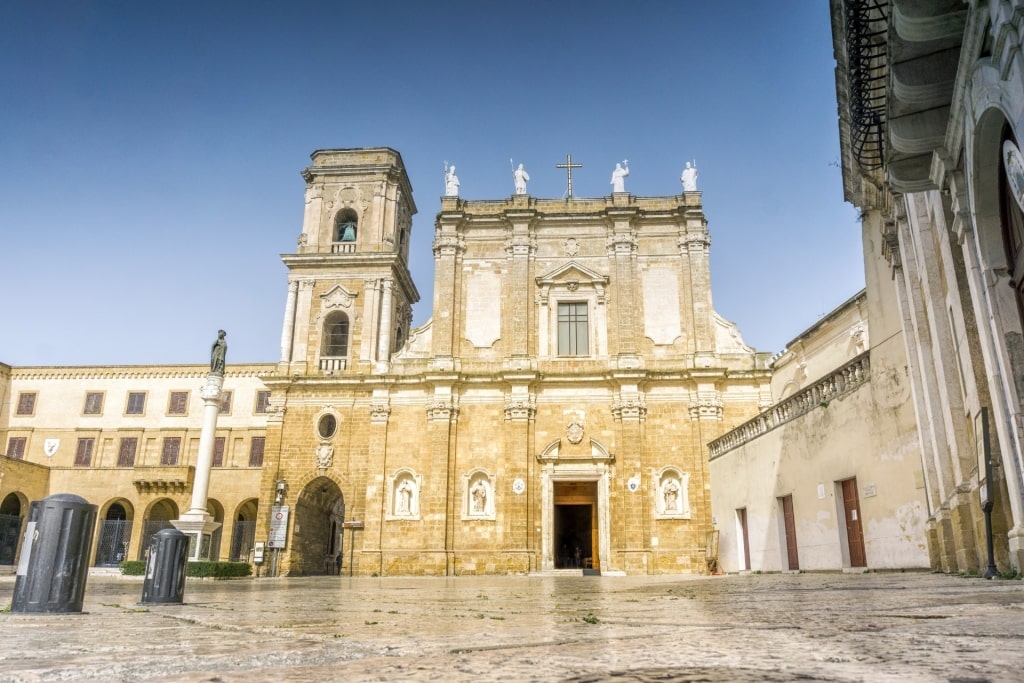
Piazza Duomo
Walk inland from the elegant Virgil Staircase, and you’ll soon make your way onto the blush-hued flagstones of the Piazza Duomo.
The cultural heart of the historical center, the Piazza Duomo, as the name suggests, is the home of the handsome cathedral or “duomo”. Originally built during the Norman era, the Basilica di S. Giovanni Battista was leveled 500 years later by a devastating earthquake.
While it was carefully rebuilt with the original 12th-century floor plan and still contains the remains of Brindisi’s dragon-fighting patron saint, Theodore of Amasea, only fragments of the original mosaic floor were recovered. Be aware that the cathedral is typically closed in the afternoon.
Beyond the duomo, the square is also the location of several other handsomely weathered buildings. To the right of the duomo is the 18th-century Episcopal Palace with its eight statues representing various intellectual disciplines.
And on the corner of Via Giovanni Tarantini is the 14th-century Loggia Balsamo engraved with intriguing medieval symbols.
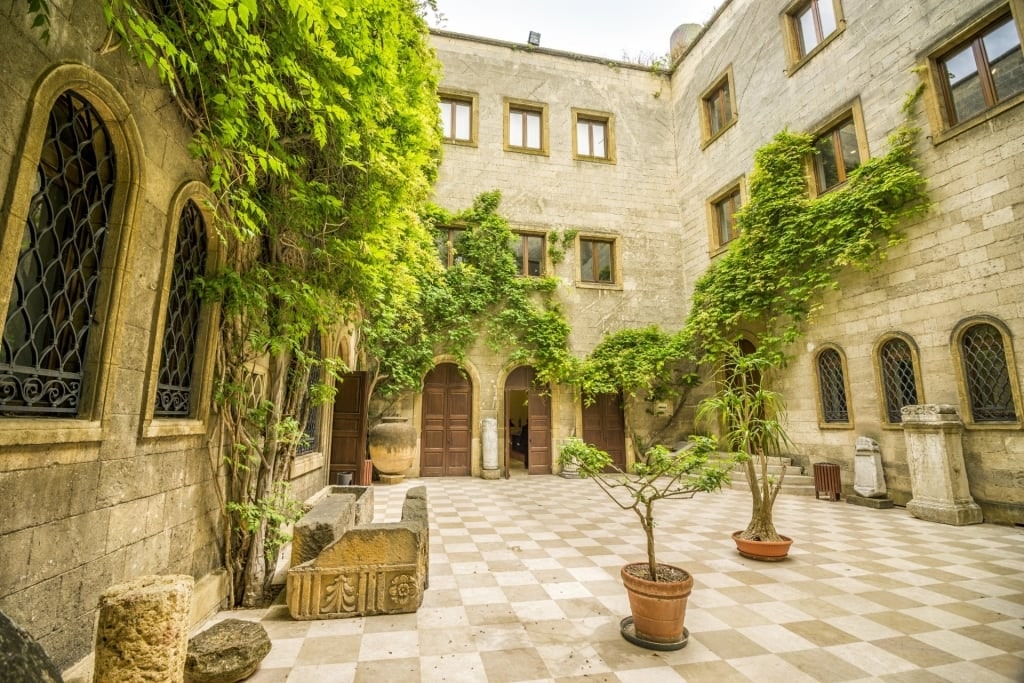
Ribezzo Archaeological Museum
If you want to dig deeper into Brindisi’s history, visit the Ribezzo Archaeological Museum, also found on the square. Over three well-curated floors, you’ll go on a journey through Brindisi’s tumultuous past. Close to 3,000 artifacts bring the city’s history to life, from pottery to bronzes and other fascinating finds, with many dredged up from the seabed.
Visit the Charming Chiesa Santa Maria del Casale
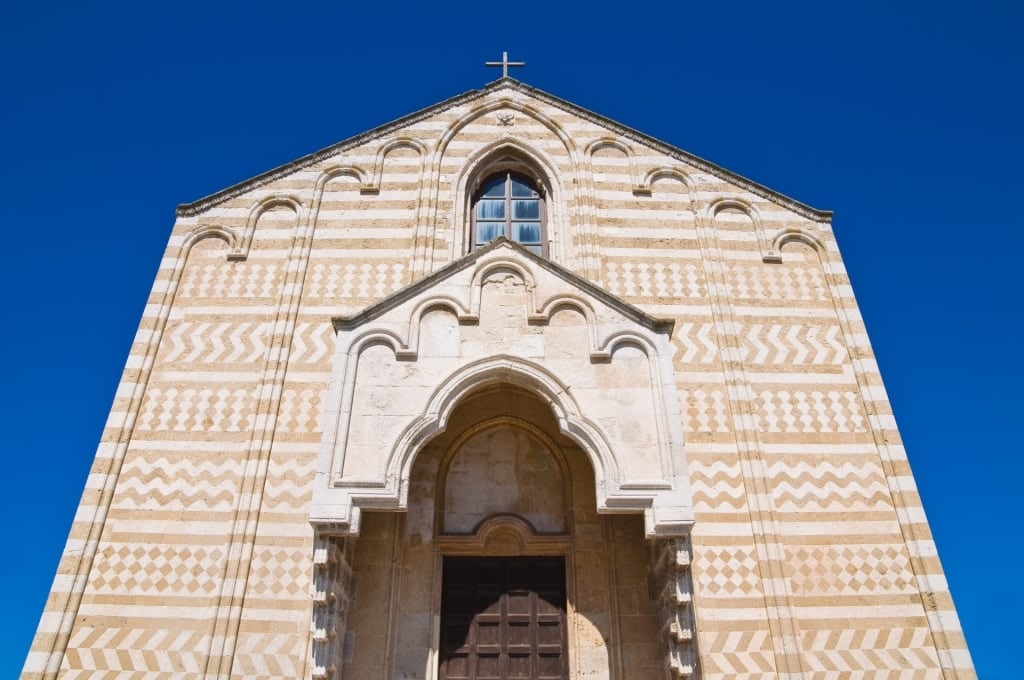
Chiesa Santa Maria del Casale
The Chiesa Santa Maria del Casale is an elegant gem of a church found close to the pragmatic modern outskirts of the airport.
Constructed in 1284 on the spot where St. Francis of Assisi reportedly once stayed on a return journey from the Middle East, the chapel has an intricate Romanesque exterior. The effect is created through the use of a particular pale stone quarried in the nearby town of Carovigno.
The church’s interior is equally striking thanks to the detailed 14th-century frescoes depicting various Bible stories.
Stroll the Rose Garden at San Giovanni al Sepolcro
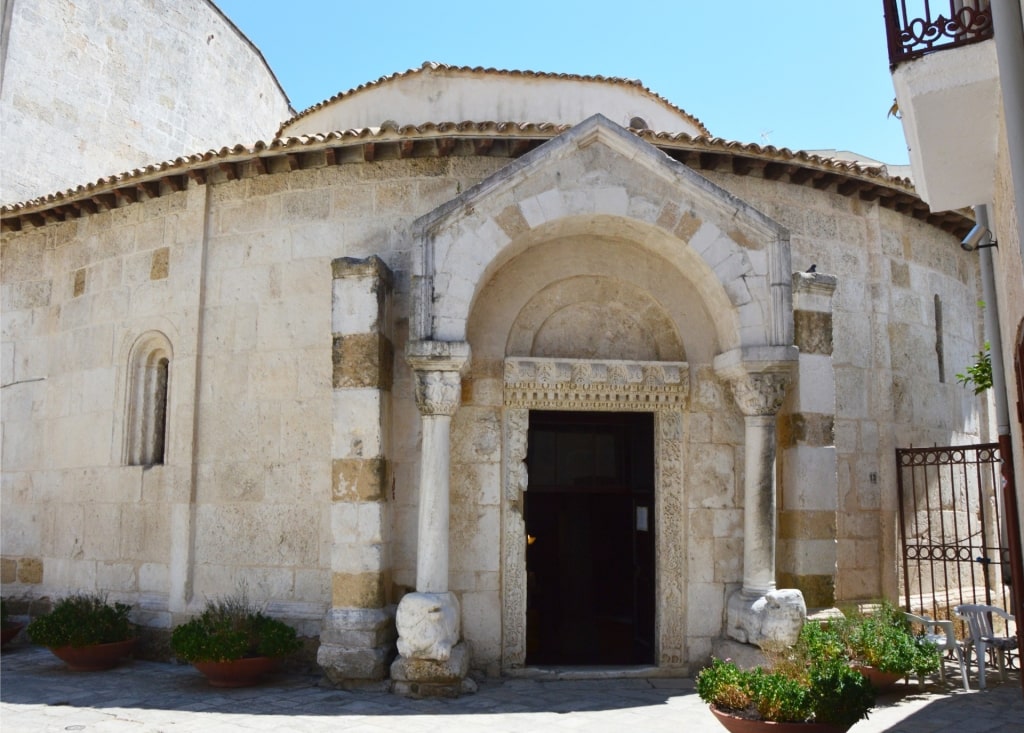
San Giovanni al Sepolcro
One of the antique treasures of the historic center is the Temple of Saint John Sepulchre or “Tempio di San Giovanni Sepolcro”. This was one of the stops where the Crusaders would pause to pray en route to Jerusalem.
In its circular interior, you’ll find walls and pillars covered in evocative medieval frescoes. Step into the fragrant rose garden to the rear for a serene retreat from modern Brindisi.
Admire Dramatic Juxtaposition at the Nuovo Teatro Giuseppe Verdi
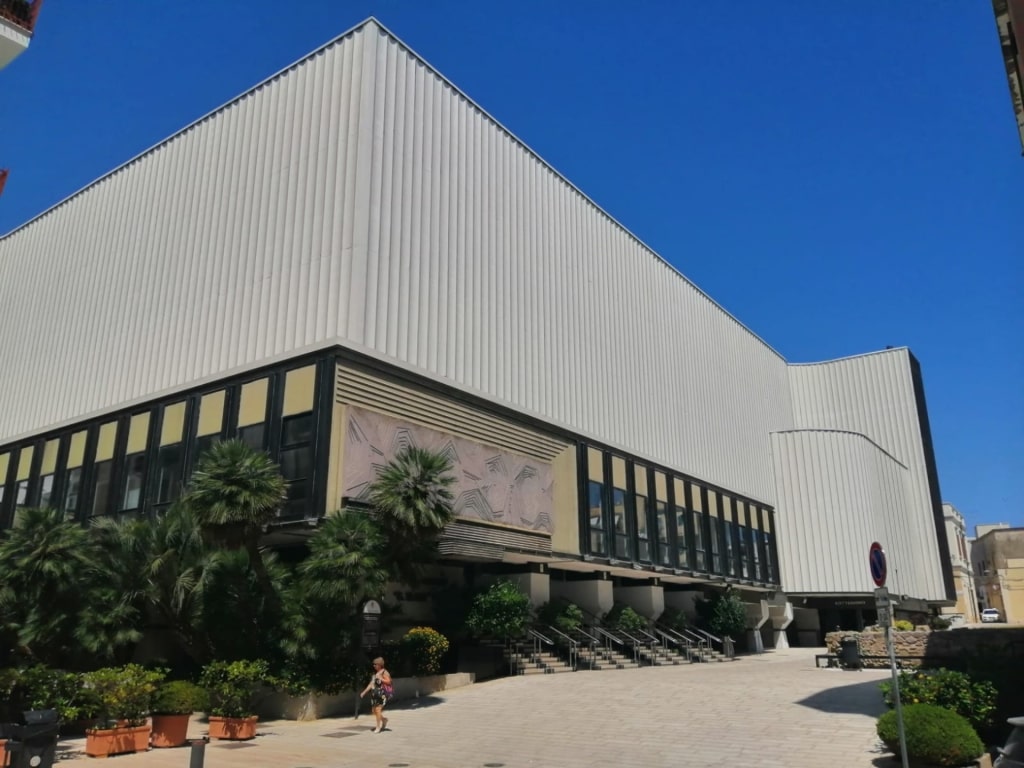
Nuovo Teatro Giuseppe Verdi Photo by Saggittarius A on Wikimedia Commons, licensed under CC BY-SA 4.0
Offering a double cultural hit in the historic center is the dashing Verdi Theater. This undulating modern building strikes a contemporary counterpoint to the historic center’s medieval mainstays.
The home of performing arts in the city, this theater is a fantastic place to catch a Verdi opera or some other quintessentially Italian cultural experience.
But besides the outstanding shows, the Verdi Theater has a trick up its sleeve. Built in what was a busy part of the city in Roman times, the Verdi is located on top of the San Pietro degli Schiavoni archaeological site. A glass floor has been installed over the remains, allowing you to look down upon the crumbling urban plan.
Take a Day Trip to Alberobello
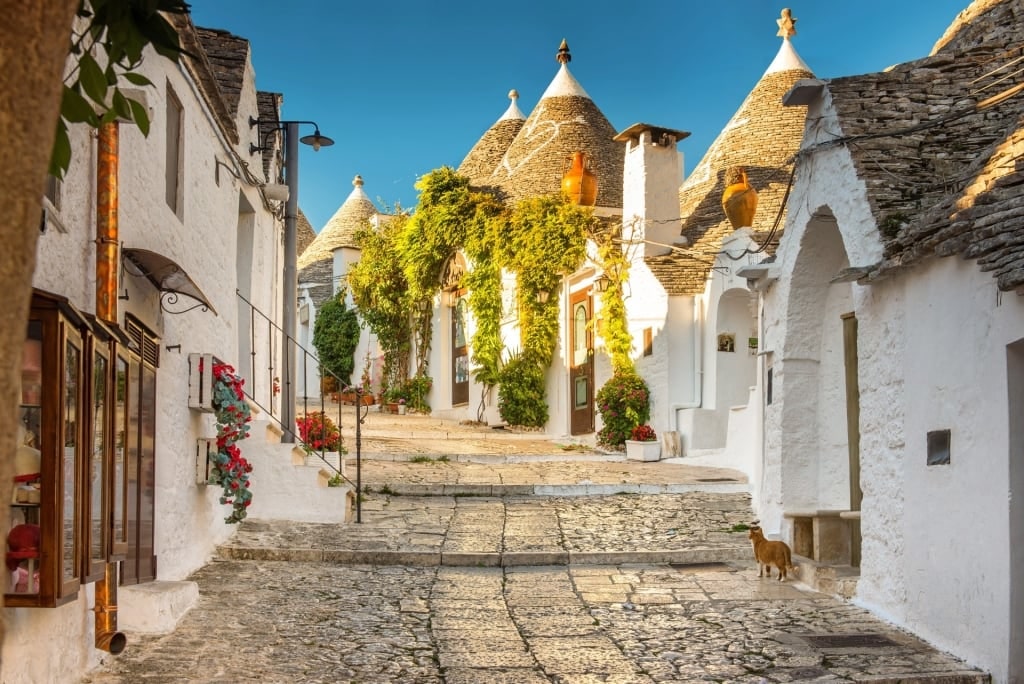
Alberobello
Brindisi’s shimmering waterfront is a charming place to while away the hours watching the boats and drinking Aperol Spritzes. However, it would almost be a crime not to visit the village of Alberobello, one of the best places to visit in Italy for the first time, which is only an hour’s drive away.
This UNESCO-protected village, in the countryside between Bari and Taranto, is a fairytale slice of Puglian culture. Almost entirely comprising the distinctive trulli houses, with their conical roofs, found in this region, it’s an utterly delightful place to explore. The streets are strung with bunting and the whitewashed houses of the Rione Monti district are brightened with well-kept window boxes.
If you find it a little touristy in places, make your way to Rione Aia Piccola, its most authentic district. And stop into its Trullo Sovrano museum to discover how the unique architecture of the trulli was developed as a medieval tax dodge.
Food & Drink
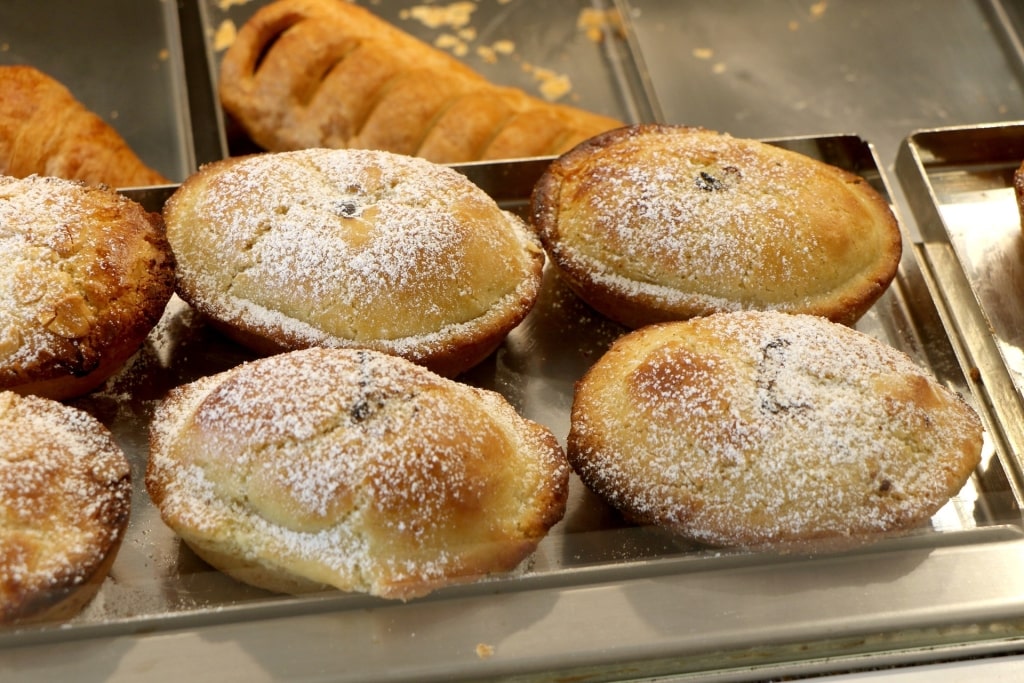
Pasticciotto
Brindisi has a good selection of restaurants, bars, and hole-in-the-walls throughout the historic center. For breakfast, find a pasticceria such as Bar Madà on Corso Umberto I and pick up a Puglian pasticciotto—a custard-filled shortcrust treat that’s magic with a morning espresso.
Alongside the uber-fresh red prawn linguine and seafood risotto that one can expect from this coastal city—try La Locanda del Porto on Via Montenegro for all things piscine—you should also look out for the kinds of things for which Puglia is rightly famed.
If you’re a fan of barbecued lamb, you’re in luck—it’s found on traditional trattoria menus throughout the Italian region. The ancient Greeks left their mark on the region’s cuisine, and this rosemary-fragranced meat is a succulent example.
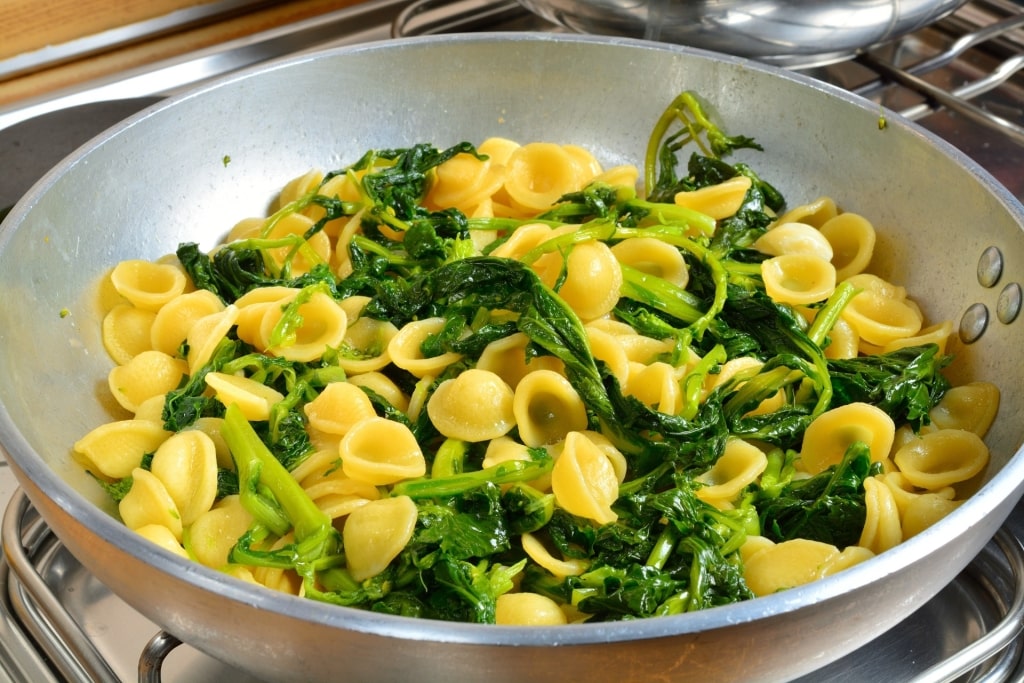
Orecchiette con Cime di Rapa
Also omnipresent is the regional pasta—orecchiette, or “little ears”. Wonderful with any kind of sauce, this pasta is outstanding in salty and fresh Orecchiette con Cime di Rapa, when it comes tossed in rapini, which is a type of broccoli, and anchovies.
Find Numero Primo Wine Bar on the promenade for a glass of local Primitivo red wine and a snack of creamy, stracciatella-filled burrata, another sumptuous Puglian invention.
Read: Best Dishes in Italy
Best Time to Visit Brindisi
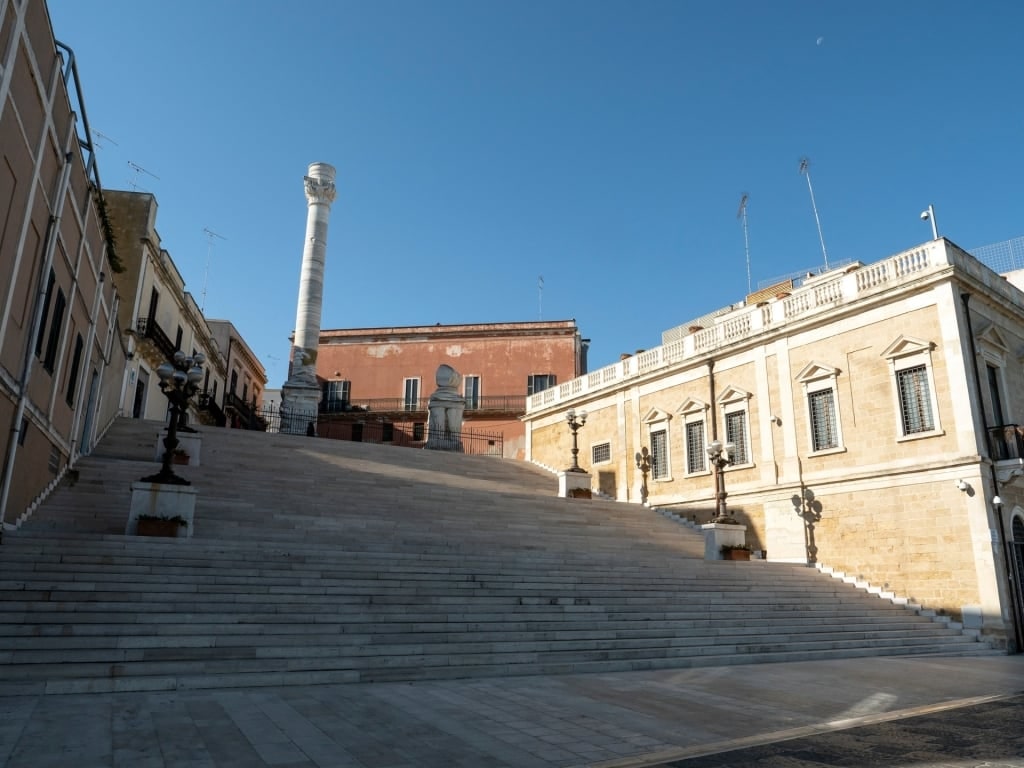
Brindisi
Puglia is a long, thin region that stretches from the “heel” of the Italian peninsula up to the protruding Gargano Peninsula. Brindisi is located in the lower half of this fertile agricultural region, facing Albania across the Adriatic Sea.
It’s a sweet spot for weather in the Mediterranean, with late spring offering daytime highs of 71°F, although you’ll probably want a light cardigan while eating al fresco along Brindisi’s promenade.
The fall is also very temperate. September is typically a couple of degrees warmer than May, and the sea, especially on the southern side, is approaching a lukewarm bath in temperature in late summer.
This begins to ebb during October in Italy, but the heat still radiates off the sun-bleached stone of the historic center, and passeggiata along Corso Umberto I is still mostly completed in short sleeves.
In high season, the sunbeds of Hemingway Beach and the other stabilimenti close to Brindisi are filled with vacationers enjoying the cooling sea breezes that take the edge off the 30°F plus inland temperatures.
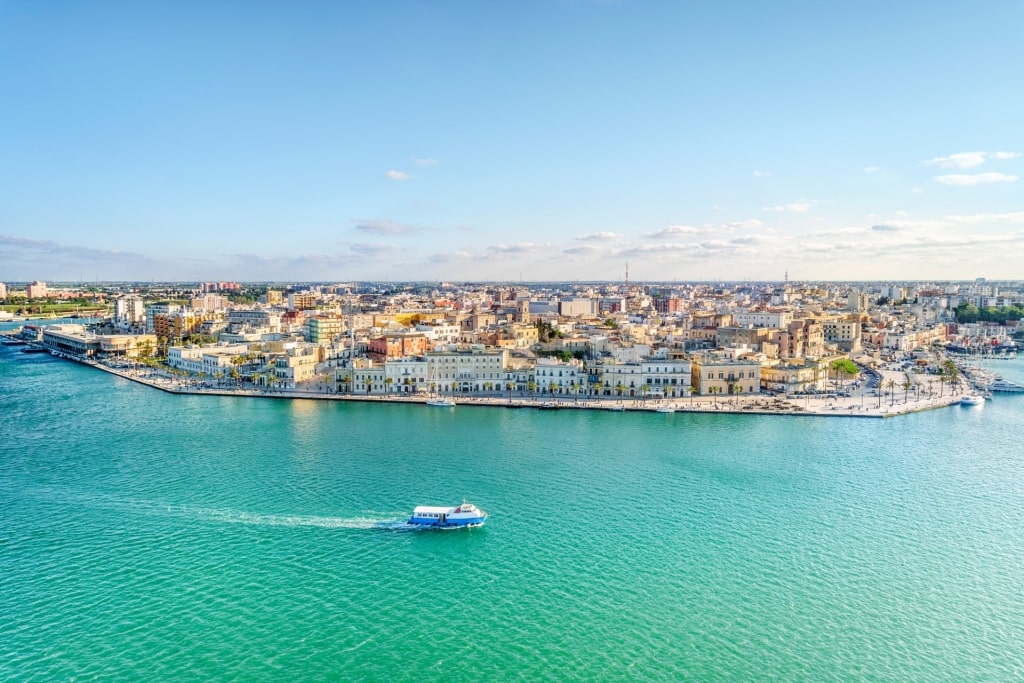
Brindisi
Wade into Brindisi’s turquoise shallows and explore Puglia’s enchanting coastline on a cruise with Celebrity. Browse our Brindisi cruises and book an Italian vacation that’ll linger long in the memory.
